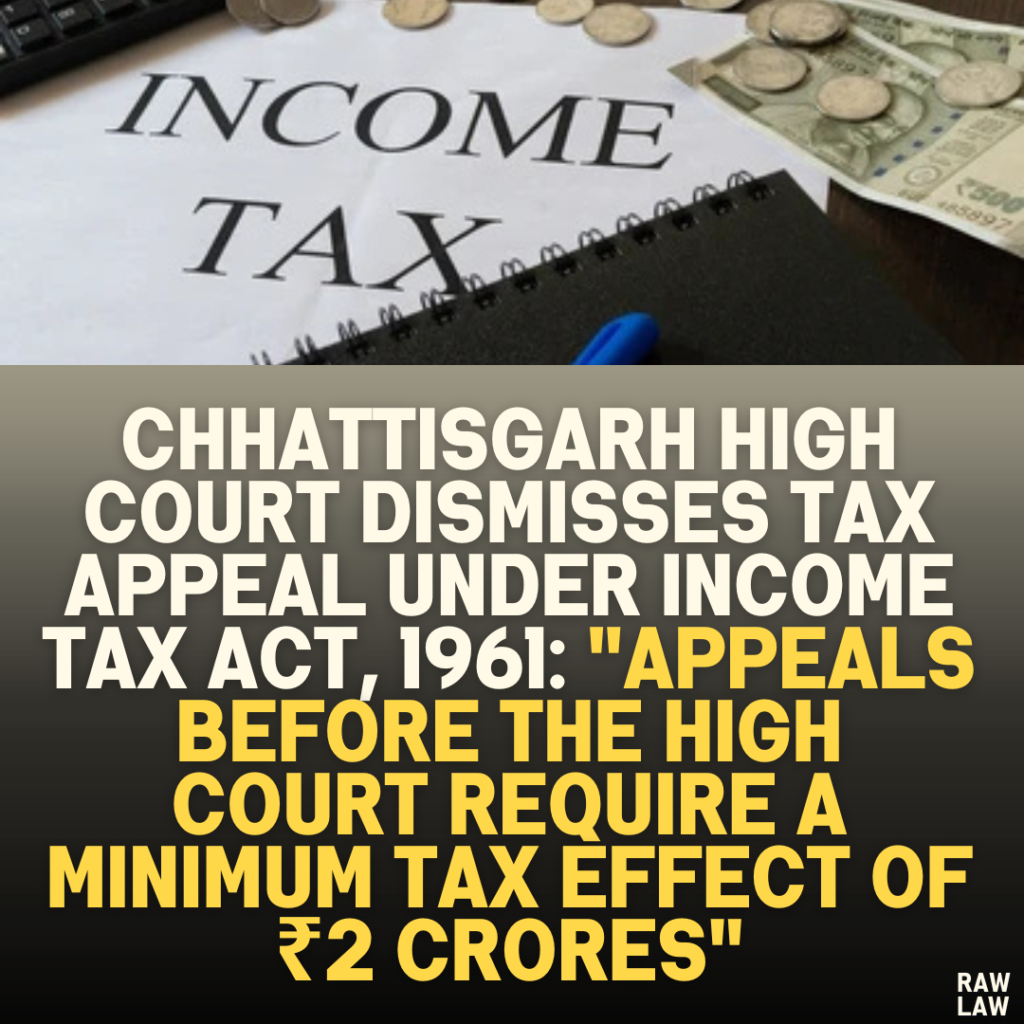Court’s Decision:
The Chhattisgarh High Court decided to dismiss the appeal because it did not meet the new criteria established by the circular from the Ministry of Finance dated 17.09.2024. The circular increased the monetary limits for filing appeals to Rs. 2 Crores for cases presented before the High Court. Since the tax liability involved in this case was less than Rs. 2 Crores, the court found the appeal inadmissible and ordered it to be dismissed as withdrawn. This means the Income Tax Department could no longer pursue this particular case in court due to the updated guidelines.
2. Facts:
- The appeal was initiated by the Principal Commissioner of Income Tax against Vandana Rolling Mills Ltd., concerning the assessment year 2017-18.
- The central issue was that the tax liability in this case was below the new monetary threshold of Rs. 2 Crores.
- During the proceedings, the department’s counsel brought up the recent circular that increased the threshold for filing appeals. The circular’s purpose was to manage litigation better and ensure that only cases with significant financial implications are pursued in higher courts.
3. Issues:
The main issue before the court was whether the appeal should continue in light of the newly established monetary limit from the Ministry of Finance. Essentially, the court needed to decide if the appeal was still valid under the updated guidelines, given that the tax liability in this case was less than Rs. 2 Crores.
4. Petitioner’s Arguments:
The petitioner’s counsel argued that:
- According to the circular dated 17.09.2024, the department should not file or continue appeals in the High Court if the tax effect is below Rs. 2 Crores.
- Since the tax liability in this case was under the specified limit, the appeal did not meet the criteria for continuation and should be withdrawn in line with the circular’s guidance.
- The argument was centered on adhering to the policy change to reduce unnecessary litigation and ensure the department focuses on cases with substantial tax liabilities.
5. Respondent’s Arguments:
The respondent, Vandana Rolling Mills Ltd., did not appear for the proceedings, and therefore, no arguments were presented from their side. The absence of the respondent meant the court primarily relied on the petitioner’s submissions and the circular’s guidelines to reach its decision.
6. Analysis of the Law:
The court analyzed the circular’s provisions, which clearly laid out the new monetary limits:
- Appeals before the Income Tax Appellate Tribunal require a tax effect of at least Rs. 60 lakhs.
- Appeals before the High Court require a minimum tax effect of Rs. 2 Crores.
- Appeals before the Supreme Court require a minimum tax effect of Rs. 5 Crores.
- The circular also provided exceptions where the department could still pursue appeals regardless of the tax effect if certain conditions were met. However, those exceptions did not apply in this case.
- The circular aimed to reduce unnecessary litigation, manage the volume of cases efficiently, and offer certainty to taxpayers regarding their assessments.
7. Precedent Analysis:
The court considered the broader implications of the circular, which not only applied to new appeals but also required the withdrawal of pending appeals if they did not meet the new monetary thresholds. This is a significant move because it means many cases currently in the system may be dismissed if their tax liabilities are below the new limits. The decision aligns with the broader intent to streamline litigation and manage court resources effectively.
8. Court’s Reasoning:
- The court agreed with the department’s counsel that withdrawing the appeal was appropriate given the circumstances. It found the submission reasonable and in line with the policy objective behind the circular.
- The key reasons behind this decision included:
- Efficiency: By withdrawing cases that don’t meet the new criteria, the court system is freed up to handle more substantial cases.
- Litigation Management: The circular’s intent is to focus the department’s resources on cases with significant financial implications, reducing the burden of minor appeals.
- The court emphasized that such guidelines help prevent frivolous or low-stakes litigation, ensuring that only significant tax disputes are contested in higher courts.
9. Conclusion:
Ultimately, the court dismissed the appeal as withdrawn, adhering strictly to the new guidelines. This decision reflects the judiciary’s role in enforcing litigation management policies set by the government, ensuring that both the department and the court system are not overburdened with minor tax disputes.
10. Implications:
- For Taxpayers: This decision provides clarity and finality for taxpayers with lower tax liabilities, ensuring they are not continually involved in prolonged legal disputes for relatively minor amounts.
- For the Income Tax Department: The department must now carefully consider the monetary thresholds before filing appeals, focusing on cases with significant financial stakes. This shift encourages better allocation of resources and a more strategic approach to litigation.
- For the Judicial System: The decision helps reduce the volume of cases in the courts, allowing for more efficient case management and quicker resolution of substantial disputes. It supports the overarching goal of improving judicial efficiency and reducing the backlog of cases.
